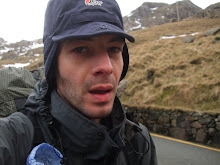
'look after the pennies and the pounds will look after themselves' but if she had, and if she had been an ultralight hiker she may have said 'look after the grams and the kilograms will look after themselves' . Which is a roundabout way of saying I have some new stuff but it's not big or exciting.
My medical kit is very basic and it's up to you what you put in yours-I'm in no way advising here just saying what I've got. In my opinion, the complex medical kits you can buy often have nothing very useful in them and realistically, in this country you are never very far away from help. If anything really major happens you're going to need mountain rescue and if it's serious but not life threatening, a bodge should see you through. So I have plasters, alcohol wipes, some ibruprofen and some duct tape. Since I was in the cubs I've assumed that you can improvise things like triangular bandages and a serious bleed is not going to be stopped by anything you can get in a normal medical kit but could be patched using a fleece hat and some duct tape for example. Over christmas, however, I cut my chin seriously enough to need five stitches. The first aider who was on the scene put on a few butterfly stitches and advised me to go to hospital. As it was Christmas and I had no wish to wait in casualty for ten hours I ignored him until the cut bled all over my pillow and I went to get it stitched. He mentioned that Americans without insurance often use super glue. I was aware of American hikers who use super glue to patch blisters but it turns out super glue has been used in medicine for a long time. When I saw these single use super glue tubes in B&Q I snapped them up. They weigh only 2g each and should be enough to patch a decent sized cut or blister if I get one (Which I usually don't). Heres a disclaimer: THIS IS NOT MEDICAL SUPER GLUE! It's got additives which may irritate skin or damage flesh if the wound is deep. I'd only use it in emergencies where I'm a significant walk away from help. It's a little bit of safety though.
If I'm adding in a bit of weight, it's nice to reduce some somewhere. The Bic mini lighter is only 11g as opposed 15g upwards for a regular, but better than that, it's much smaller. It helps if you remove the child safety strip, which is really easy to do. I use it for burning my toilet paper and as a secondary fire source.
My new primary fire source is the mini firesteel (9g). Eddie Meechan did a good write up on this inTGO, but instead of using a bit of hacksaw for a striker, I'm using my Swiss Army knife(22g). Iv'e struggled mentally with carrying the SAK for a while now-I did try using a razor blade instead of a knife for a while as I virtually never use a knife but I felt like the scissors may come in useful. It also carries tweezers and a toothpick (Useful for beef Jerky!). It really is a 'just in case' item which is rarely used. The use of it for a striker justifies it's existence in my pack a little more!




2 comments:
I went for a small Swiss Army knife myself, it's nice to have a blade but the scissors were what I was really after. Choosing the knife, mines a Wenger Classic (24g inc cord) meant I could leave my normal pocket knife (98g) and remove the Camp folding scissors from my 1st aid kit. The stainless steel blade isn't as good a carbon steel for using with a flint but I roughed up the spine of the file blade for the purpose.
Be careful using superglue on cuts, if the wound isn't totally clean and it gets infected it won't re-open like a normal scab.
The superglue would only ever be a last resort but it's there in that eventuality.
Post a Comment